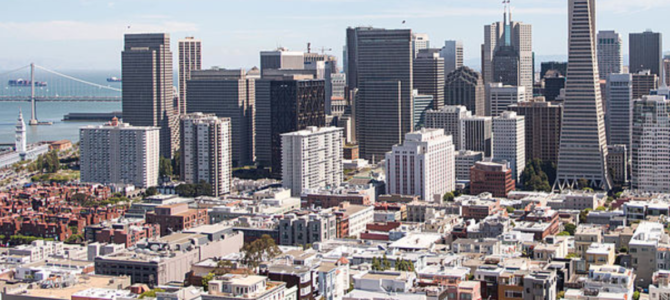
As the once great state of California continues its imperial decline, the cities of the American West are booming. The Golden State is losing its shine and is no longer the magnet of its post-World War II heyday, when American prosperity drew millions to its sunny shores.
Military veterans who had passed through on their way to the South Pacific liked what they saw and returned after the war. Other folks came west as they had in the age of manifest destiny. The state is the epicenter of the birth of 75 million baby boomers.
All that has changed. California, despite its $3 trillion economy, is now routinely described by pundits as the equivalent of a Third World country. It has some of the highest state and local tax rates in the nation. Mostly thanks to illegal immigration, 27 percent of people there were born in a foreign country, likely one in Latin America. Sanctuary city policies have increased crime rates, with local municipalities refusing to cooperate with Immigration and Customs Enforcement to detain or deport documented criminals.
Some 150,000 homeless people inhabit public places, and cities such as Los Angeles and San Francisco are increasingly unlivable, with the latter boasting the highest property crime rates in the country, rampant outdoor sanitation problems, and addiction and mental health problems in much of the homeless demographic. Always susceptible to wildfires, California has suffered horribly from them the last few years, resulting in lost lives and billions of dollars in property damage. Many of the fires emanate from decrepit Pacific Gas and Electric infrastructure, resulting in the blackouts that affect millions and cause economic chaos in towns and cities in wine country and the Sierra Foothills.
People and Businesses Are Leaving California in Droves
According to the San Diego Union-Tribune, California’s population grew by 141,300 people between July 1, 2018, and July 1, 2019. Despite a positive “net international migration,” there was “negative domestic net migration,” resulting in a loss of 39,500 residents. California now has “more people leaving the state than moving in [legally] from abroad or from other states.”
The main beneficiaries of this outmigration are Arizona, Colorado, Nevada — roughly 50,000 Californians moved to Nevada in just one year: July 2017 to July 2018 — Oregon, Texas, and Washington state. California risks losing a seat in the House of Representatives after the results of the 2020 census are tallied. It also suffers from a baby bust. Los Angeles County, for instance, saw a “17% decline in the amount of children in the area over the last decade.”
If 2020 census projections are accurate, Arizona, Colorado, Montana, Oregon, and North Carolina will each gain one House seat, the latter likewise a recipient of outmigration from the Midwest and Northeast. Florida will gain two and Texas three.
The Lone Star State seems to be benefitting from California businesses, large and small, relocating to the booming cities of Dallas-Fort Worth, Houston, Austin, and others. For example, the Charles Schwab Corporation is moving its headquarters from San Francisco to Westlake, a Dallas-Fort Worth suburb, in the next 18 to 36 months. Oracle is moving its annual tech convention from San Francisco to Las Vegas due to the former city’s chronic homelessness and crime problems. San Francisco will lose $64 million in convention business from this one event. Ironically enough, the Golden State’s powerhouse economy is bleeding economic wealth.
Much of that is a product of California’s real estate market. The average price of a home statewide is $550,000. In upscale San Francisco, that number is roughly $1.4 million. The average price of a home in Boise, Idaho, is $323,540. Do the math. Californians are arriving in Treasure Valley with two to four times the equity needed to purchase a property comparable to the one they sold in California. This ratio applies in varying degrees to most other western cities.
U.S. Cities Are Benefitting from California’s Demise
Those cities over the last generation have benefitted from The Golden State’s decline. Much of the outmigration was a function of the technological innovation we have seen since the mid-1990s. The American economy was increasingly mobile. Entrepreneurs could do business anywhere.
Local amenities from skiing to hiking and fly fishing attracted outdoor enthusiasts — hence the economic growth in cities such as Denver, Phoenix, Salt Lake City, Boise, Las Vegas, and Reno. They all experienced exponential growth in building construction and retail expansion, with the attendant scourge of traffic congestion. Local pundits and demographers came to call this the “New West.”
According to the Associated Press, there are now “more adults in Nevada who were born in California than native Nevadans.” In Utah, as economist Stephen Moore wrote for the Wall Street Journal, “almost 80,000 newcomers (mostly young) over the past decade” have contributed to economic growth that has put the state at No. 1 in many categories. State income and corporate tax rates below 5 percent, and the absence of an estate tax has stimulated growth and attracted retirees to Utah’s ski slopes and sunny, red-rock deserts.
Idaho has also benefited from a combination of the Trump economy and the political and cultural, if not economic, decline of California, as Californians are arriving in the Treasure Valley in droves. Ongoing construction of apartment complexes and single-family home subdivisions with units numbering in the hundreds, if not thousands, are filling up the more traditionally rural parts of the area. Not all of this outmigration is positive, of course: Boise and its environs are typical of many western cities in their shared traffic congestion and overcrowded schools, and such growth leads to higher property taxes as municipalities struggle to address infrastructure problems.
The roaring Trump economy and the results of the 2017 tax reform, along with California’s political and cultural suicidal tendencies, will ensure the American West’s economic boom will continue for years to come.









